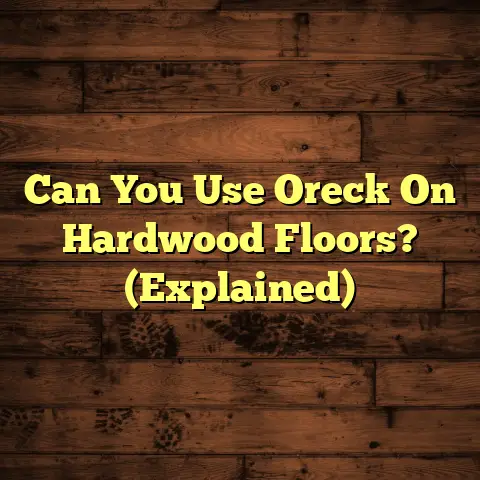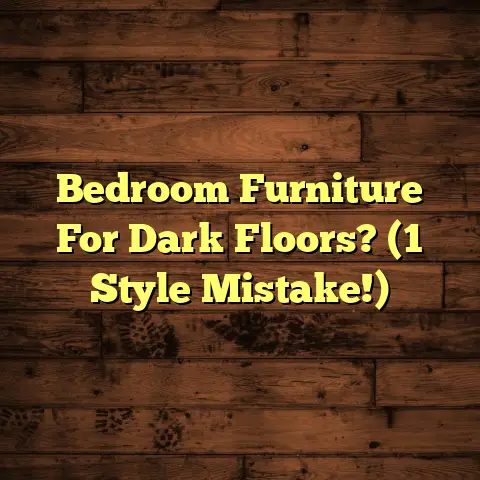Can U Clean Wood Floors With Bleach? (Explained)
I once thought cleaning wood floors with bleach would be like sending them on a spa day—brightening their looks and giving them a fresh start. Little did I know, that was more of a one-way ticket to the wood floor graveyard! As a flooring contractor, I’ve had my share of mishaps, and I’m here to share my journey of trials and errors, along with valuable insights. So, can you really clean wood floors with bleach? Let’s find out together as I take you through my experiences, successes, challenges, and everything in between.
The Bleach Dilemma
When I first started my flooring business, I was eager to learn every cleaning trick in the book. A client once asked if they could use bleach on their beautiful oak floors. I shrugged and thought, “Why not?” After all, bleach is a powerful cleaner, right? Spoiler alert: it’s not always the best option for wood.
The Reality Check
I decided to test it on a small area of my own wood floor. Armed with a diluted bleach solution, I got to work. At first, I was thrilled to see how quickly it lifted some stubborn stains. But after a few minutes, the joy faded. The surface started looking dull and lifeless. It didn’t take long for me to realize that bleach can strip the finish off wood floors, leaving them vulnerable to damage.
What Happens When You Use Bleach?
Bleach is an effective disinfectant and stain remover, but it’s also harsh. It can:
- Damage the Finish: Most wood floors are coated with a protective finish. Bleach can break down this layer, exposing the wood beneath.
- Discolor the Wood: Over time, it can fade the color of your wood floors, leaving behind unsightly spots.
- Dry Out the Wood: It can lead to cracking and splitting as wood absorbs moisture from the air.
So, what’s the takeaway? Avoid using bleach on your wood floors like you would avoid stepping on a Lego in the dark!
Understanding Wood Floor Finishes
To understand why cleaning with bleach is problematic, let’s take a closer look at the types of finishes commonly used on wood floors. This will help clarify how bleach interacts with them.
Types of Finishes
- Polyurethane: This is a popular choice for both residential and commercial spaces due to its durability. Polyurethane finishes create a hard barrier that protects the wood from moisture and wear.
- Oil-Based Finishes: These provide a rich color and shine but require more maintenance than polyurethane finishes. They penetrate the wood and enhance its natural beauty.
- Water-Based Finishes: These are less toxic and dry quickly but may not be as durable as oil-based options. However, they are becoming increasingly popular due to their environmental benefits.
Understanding these finishes is crucial because the type of finish will dictate how your wood floor reacts to different cleaning methods, including bleach.
Alternatives to Bleach
Now that we’ve established that bleach is not the friend we thought it was, let’s explore some safer alternatives for cleaning wood floors that will leave them gleaming without the risk of damage.
Vinegar and Water Solution
One of my go-to solutions is a mixture of vinegar and water. It’s simple and effective. Here’s how I do it:
- Mix: Combine one cup of white vinegar with a gallon of warm water.
- Mop: Use a microfiber mop to apply the solution. Make sure it’s damp, not soaking wet.
- Dry: Wipe up any excess moisture with a dry cloth.
This method works wonders for light cleaning and helps remove dirt without damaging the finish.
Commercial Wood Floor Cleaners
I’ve tried various commercial cleaners specifically designed for wood floors. They’re formulated to clean effectively without harming the finish. Brands like Bona or Murphy’s Oil Soap have become staples in my cleaning routine.
I remember one project where I had to clean up after some construction dust settled on newly installed floors. A quick spray of Bona’s cleaner followed by a gentle mop made it look brand new without any risk of damage.
Essential Oils for Freshness
To add a pleasant scent while cleaning, I sometimes toss in a few drops of essential oils like lemon or lavender into my vinegar solution. It not only smells great but also adds an extra layer of cleaning power!
My Cleaning Routine: Step-by-Step
After some trial and error, I developed a routine that works for me:
- Sweep or Vacuum: Always start by removing dust and dirt.
- Choose Your Cleaner: Depending on the mess, I either use vinegar or a commercial cleaner.
- Mop Lightly: Apply your chosen cleaner using a damp mop.
- Dry Immediately: Wipe up any excess moisture to prevent water damage.
- Regular Maintenance: A quick sweep or vacuum every few days keeps dirt from building up.
Additional Cleaning Tips
Here are some more tips I learned over the years:
- Spot Cleaning: For tough stains like wine or pet accidents, I recommend using a concentrated solution of your cleaning agent directly on the stain before mopping.
- Avoid Harsh Scrubbing: Stick to soft mops or cloths to avoid scratching the surface.
- Follow Up with a Dry Mop: After mopping, going over the floor with a dry mop can help eliminate any residual moisture.
Cost Estimation and Planning
As an experienced flooring contractor, budgeting is crucial for me and my clients. When estimating costs for floor installation or maintenance, using tools like FloorTally has been incredibly helpful.
With FloorTally, I can input different flooring types and their associated costs, including cleaning supplies and maintenance expenses. This allows me to provide clients with realistic budgets that encompass all aspects of their project.
For instance, when working on a recent residential project in Dhaka, I had to account for various cleaning products alongside the flooring costs. Thanks to FloorTally’s comprehensive approach, I estimated about $1,500 for hardwood installation and an additional $200 for cleaning supplies over the next year.
Breakdown of Costs
- Flooring Installation: Approximately $1,500
- Cleaning Supplies (Annual):
- Vinegar ($10)
- Commercial cleaner ($30)
- Essential oils ($15)
- Microfiber mops ($20)
This way, clients can fully understand what they are investing in—not just for installation but also for keeping their beautiful floors in pristine condition.
The Challenges
Not every job goes smoothly. I’ve encountered some challenges while cleaning and maintaining wood floors:
- Stubborn Stains: Occasionally, I’ve faced tough stains from pet accidents or spilled drinks. These require more than just regular cleaning solutions. For example, I had one client whose dog had an unfortunate accident on their new hardwood floors. The stain was deeply set in and required multiple treatments with specialized pet stain removers before it finally came out.
- Neglecting Maintenance: Clients sometimes forget about regular upkeep, leading to long-term damage that’s costlier to fix. I had one homeowner who hadn’t cleaned their floors in over six months; by the time we got to them, they needed sanding and refinishing—a much bigger job than anticipated!
- Miscommunication: Some clients believe all cleaners are safe for wood floors, so I make it a point to educate them on what works best.
I remember one project where a client used bleach without asking me first—let’s just say they weren’t pleased with the results!
Comparing Cleaning Methods
Let’s break down some of the different cleaning methods I’ve tried over the years:
Vinegar vs. Commercial Cleaners
- Vinegar
- Pros: Inexpensive, natural disinfectant.
- Cons: Can leave streaks if not dried properly; strong smell during use.
- Commercial Cleaners
- Pros: Specifically formulated for wood; usually leaves no residue.
- Cons: Can be more expensive; some may contain harsh chemicals.
In my experience, vinegar works well for routine cleanings whereas commercial cleaners shine when dealing with sticky messes or significant buildup.
DIY Solutions vs. Store-Bought Options
I love DIY solutions because they’re often cheaper and allow me to control what goes into them. However, store-bought options often provide convenience and specific formulations that DIY just can’t replicate.
For instance, there was one time when I mixed baking soda with vinegar thinking I’d create an awesome cleaner—only to end up with a foamy mess that made more work than it solved!
Maintaining Wood Floors Over Time
Maintaining your wood floors isn’t just about cleaning; it’s about preserving their integrity over time.
Regular Inspections
Every few months, I recommend inspecting your floors for signs of damage like scratches or dull spots. Catching these issues early can prevent bigger problems down the line.
Refinishing When Necessary
Over time, even well-maintained floors may need refinishing due to wear and tear. Signs that it’s time include:
- Dullness that doesn’t improve with cleaning.
- Visible scratches or dents.
- Water damage spots that won’t come out.
In one case, I refinished an old oak floor for a client who thought it was beyond saving—the transformation was stunning!
Seasonal Care Tips
Seasonal changes can affect your wood floors:
- Winter: Use mats at entrances to catch snow or salt residues.
- Summer: Keep blinds closed during peak sun hours to prevent fading.
A Final Thought
In my experience as a flooring contractor, understanding how to maintain wood floors properly can save you time and money in the long run. While cleaning with bleach might seem tempting for those tough stains, it’s simply not worth the risk.
Instead, opt for safer alternatives that preserve your floor’s beauty and longevity. Whether it’s using vinegar or investing in specialized cleaners, make informed choices to keep your wood floors looking their best.
If you ever wonder whether bleach is the right choice for your wood floors again, just remember my mishap—and maybe we can share a laugh over it!





